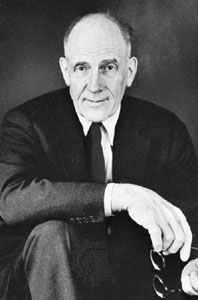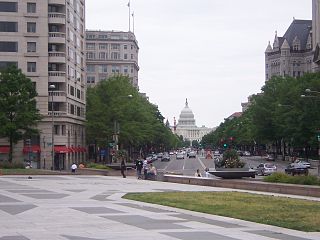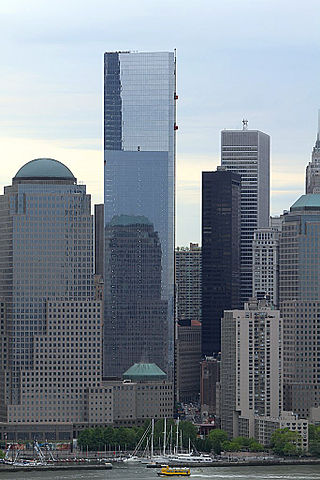
Minoru Yamasaki was a Japanese-American architect, best known for designing the original World Trade Center in New York City and several other large-scale projects. Yamasaki was one of the most prominent architects of the 20th century. He and fellow architect Edward Durell Stone are generally considered to be the two master practitioners of "New Formalism".

Wallace Kirkman Harrison was an American architect. Harrison started his professional career with the firm of Corbett, Harrison & MacMurray, participating in the construction of Rockefeller Center. He is best known for executing large public projects in New York City and upstate, many of them a result of his long and fruitful personal relationship with Nelson Rockefeller, for whom he served as an adviser.

Skidmore, Owings & Merrill LLP (SOM) is an American architectural, urban planning and engineering firm. It was founded in 1936 by Louis Skidmore and Nathaniel Owings in Chicago. In 1939, they were joined by engineer John Merrill. The firm opened its second office, in New York City, in 1937 and has since expanded, with additional offices in San Francisco, Los Angeles, Washington, D.C., London, Melbourne, Hong Kong, Shanghai, Seattle, and Dubai.

The World Trade Center site, often referred to as "Ground Zero" or "the Pile" immediately after the September 11 attacks, is a 14.6-acre (5.9 ha) area in Lower Manhattan in New York City. The site is bounded by Vesey Street to the north, the West Side Highway to the west, Liberty Street to the south, and Church Street to the east. The Port Authority of New York and New Jersey (PANYNJ) owns the site's land. The original World Trade Center complex stood on the site until it was destroyed in the September 11 attacks.

Gordon Bunshaft was an American architect, a leading proponent of modern design in the mid-twentieth century. A partner in Skidmore, Owings & Merrill (SOM), Bunshaft joined the firm in 1937 and remained with it for more than 40 years. His notable buildings include Lever House in New York, the Beinecke Rare Book and Manuscript Library at Yale University, the Hirshhorn Museum and Sculpture Garden in Washington, D.C., the National Commercial Bank in Jeddah, Saudi Arabia, 140 Broadway, and Manufacturers Hanover Trust Branch Bank in New York.

Larry A. Silverstein is an American businessman. Among his real estate projects, he is the developer of the rebuilt World Trade Center complex in Lower Manhattan, New York City, as well as one of New York's tallest residential towers at 30 Park Place, where he owns a home.

Paul Philippe Cret was a French-born Philadelphian architect and industrial designer. For more than thirty years, he taught at a design studio in the Department of Architecture at the University of Pennsylvania.

Pennsylvania Avenue National Historic Site is a National Historic Site in the city of Washington, D.C. Established on September 30, 1965, the site is roughly bounded by Constitution Avenue, 15th Street NW, F Street NW, and 3rd Street NW. The historic district includes a number of culturally, aesthetically, and historically significant structures and places, including Pennsylvania Avenue NW from the White House to the United States Capitol, the Treasury Building, Freedom Plaza, Federal Triangle, Ford's Theatre, the Old Patent Office Building, the Old Pension Office Building, which now houses the National Building Museum, Judiciary Square, and the Peace Monument.
Roger Duffy is an American architect, known for rigorous and unconventional approach to design. Now retired, he worked as a partner at the firm Skidmore, Owings & Merrill. He was a design partner in the New York office from 1995 until 2018, and is a member of the American Institute of Architects and the League Circle of the Architectural League of New York.

One World Trade Center, also known as One World Trade, One WTC, and formerly called the Freedom Tower during initial planning stages, is the main building of the rebuilt World Trade Center complex in Lower Manhattan, New York City. Designed by David Childs of Skidmore, Owings & Merrill, One World Trade Center is the tallest building in the United States, the tallest building in the Western Hemisphere, and the seventh-tallest in the world. The supertall structure has the same name as the North Tower of the original World Trade Center, which was destroyed in the terrorist attacks of September 11, 2001. The new skyscraper stands on the northwest corner of the 16-acre (6.5 ha) World Trade Center site, on the site of the original 6 World Trade Center. It is bounded by West Street to the west, Vesey Street to the north, Fulton Street to the south, and Washington Street to the east.
Joshua Ramus is the founding principal of REX, an architecture and design firm based in New York City.

Der Scutt was an American architect and designer of a number of major and notable buildings throughout New York City and the United States.

4 World Trade Center is a skyscraper constructed as part of the new World Trade Center in Lower Manhattan, New York City. The tower is located on Greenwich Street at the southeastern corner of the World Trade Center site. Fumihiko Maki designed the 978 ft-tall (298 m) building. It houses the headquarters of the Port Authority of New York and New Jersey (PANYNJ).

Nathaniel Alexander Owings was an American architect, a founding partner of Skidmore, Owings & Merrill, which became one of the largest architectural firms in the United States and the world. Owings viewed skyscrapers as his firm's specialty. His reputation rested on his ability to be what he called "the catalyst," the person in his firm who ironed out differences among clients, contractors and planning commissions.
T. J. Gottesdiener is an architect and managing partner of the New York office of Skidmore, Owings & Merrill (SOM). A graduate of Cooper Union’s Irwin S. Chanin School of Architecture, Gottesdiener joined SOM in 1980 and was made Partner in 1994. He lives with his wife in New York City; they have one son.
Cosentini Associates is an engineering firm that provides consulting engineering services for the building industry.

2 World Trade Center is a planned skyscraper as part of the World Trade Center complex in Manhattan, New York City. It will replace the original 2 World Trade Center, which was completed in 1972 and subsequently destroyed during the September 11 attacks in 2001, and it will occupy the position of the original 5 World Trade Center. The foundation work was completed in 2013, though no construction has taken place since.

The Twin Towers II was a proposed twin-towered skyscraper complex which would have been located at the World Trade Center site in Manhattan, New York City. The proposed complex would have replaced the former Twin Towers of the World Trade Center destroyed in the September 11 attacks, restoring the skyline of the city to its former state. The main design for the proposed complex would feature new landmark twin towers, nearly identical to the originals designed by Minoru Yamasaki, though it would feature 115 stories—5 floors taller than the originals, among other differences. Beside the towers, an above-ground memorial would have occupied the footprints of the original towers. The new site would also have featured three 12-story buildings, replacing the original 3, 4 and 5 World Trade Center. The complex was designed and developed by American architect Herbert Belton and American engineer Kenneth Gardner, and sponsored by Donald Trump.

The World Trade Center (WTC) is a complex of buildings in the Lower Manhattan neighborhood of New York City, replacing the original seven buildings on the same site that were destroyed in the September 11 attacks of 2001. The site is being rebuilt with up to six new skyscrapers, four of which have been completed; a memorial and museum to those killed in the attacks; the elevated Liberty Park adjacent to the site, containing the St. Nicholas Greek Orthodox Church and the Vehicular Security Center; the Perelman Performing Arts Center; and a transportation hub. The 104-story One World Trade Center, the tallest building in the Western Hemisphere, is the lead building for the new complex.

Gary Paul Haney FRIBA, FAIA is an American architect, a design partner in the firm of Skidmore, Owings & Merrill. Haney's approach draws heavily on environmental modeling techniques, deep materials research, and advanced building information modeling (BIM) technologies. Buildings on which he was lead designer include the supertall Al Hamra Tower in Kuwait City and civic buildings in the United States including two Public Safety Answering Centers in New York City and the United States Census Bureau headquarters and the redesign of the National Museum of American History, both in Washington, D.C.

















